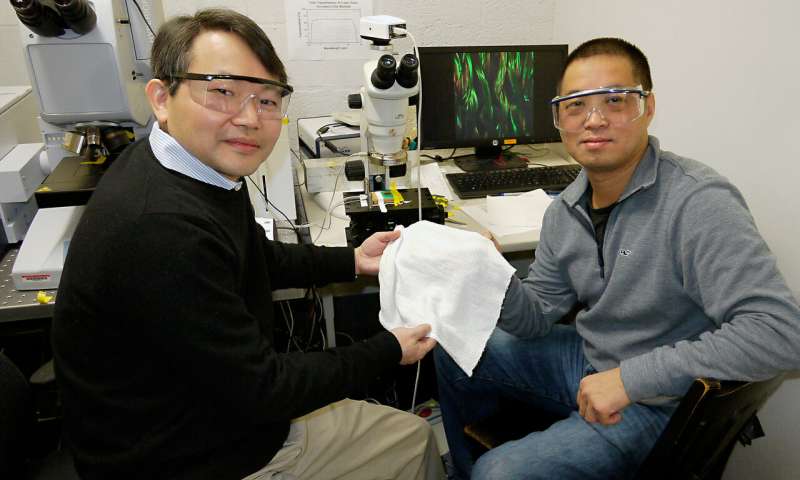The remarkable properties of a recently-discovered squid protein could revolutionize materials in a way that would be unattainable with conventional plastic, finds a review published in Frontiers in Chemistry. Originating in the ringed teeth of a squid’s predatory arms, this protein can be processed into fibers and films with applications ranging from ‘smart’ clothes for health monitoring, to self-healing recyclable fabrics that reduce microplastic pollution. Materials made from this protein are eco-friendly and biodegradable, with sustainable large-scale production achieved using laboratory culture methods.
“Squid proteins can be used to produce next generation materials for an array of fields including energy and biomedicine, as well as the security and defense sector,” says lead author Melik Demirel, Lloyd and Dorothy Foehr Huck Endowed Chair in Biomimetic Materials, and Director of Center for Research on Advanced Fiber Technologies (CRAFT) at Penn State University, USA. “We reviewed the current knowledge on squid ring teeth-based materials, which are an excellent alternative to plastics because they are eco-friendly and environmentally sustainable.”
Squid ring teeth are all-rounders
As humanity awakens to the aftermath of a 100-year party of plastic production, we are beginning to heed nature’s warnings—and its solutions.
“Nature produces a variety of smart materials capable of environmental sensing, self-healing and exceptional mechanical function. These materials, or biopolymers, have unique physical properties that are not readily found in synthetic polymers like plastic. Importantly, biopolymers are sustainable and can be engineered to enhance their physical properties,” explains Demirel.
The oceans, which have borne the brunt of plastic pollution, are at the center of the search for sustainable alternatives. A newly-discovered protein from squid ring teeth (SRT) – circular predatory appendages located on the suction cups of squid, used to strongly grasp prey—has gained interest because of its remarkable properties and sustainable production.
The elasticity, flexibility and strength of SRT-based materials, as well as their self-healing, optical, and thermal and electrical conducting properties, can be explained by the variety of molecular arrangements they can adopt. SRT proteins are composed of building blocks arranged in such a way that micro-phase separation occurs. This is a similar situation to oil and water but on a much smaller, nano-scale. The blocks cannot separate completely to produce two distinct layers, so instead molecular-level shapes are created, such as repeating cylindrical blocks, disordered tangles or ordered layers. The shapes formed dictate the property of the material and scientists have experimented with these to produce SRT-based products for a variety of uses.
In the textiles industry, SRT protein could address one of the main sources of microplastic pollution by providing an abrasion-resistant coating that reduces microfiber erosion in washing machines. Similarly, a self-healing SRT protein coating could increase the longevity and safety of damage-prone biochemical implants, as well as garments tailored for protection against chemical and biological warfare agents.
It is even possible to interleave multiple layers of SRT proteins with other compounds or technology, which could lead to the development of ‘smart’ clothes that can protect us from pollutants in the air while also keeping an eye on our health. The optical properties of SRT-based materials mean these clothes could also display information about our health or surroundings. Flexible SRT-based photonic devices—components that create, manipulate or detect light, such as LEDs and optical displays, which are typically manufactured with hard materials like glass and quartz—are currently in development.
“SRT photonics are biocompatible and biodegradable, so could be used to make not only wearable health monitors but also implantable devices for biosensing and biodetection,” adds Demirel.
No squid was harmed in the making of this film
One of the main advantages of SRT-based materials over synthetic materials and plastics made from fossil fuels are its eco-credentials. SRT proteins are cheaply and easily produced from renewable resources and researchers have found a way of producing it without catching a squid.”We don’t want to deplete natural squid resources and hence we produce these proteins in genetically modified bacteria. The process is based on fermentation and uses sugar, water, and oxygen to produce biopolymers,” explains Demirel.
It is hoped that the SRT-based prototypes will soon become available more widely, but more development is needed.
Demirel explains, “Scaling up these materials requires additional work. We are now working on the processing technology of these materials so that we can make them available in industrial manufacturing processes.”
Read more at: https://phys.org/news/2019-02-squid-eco-friendly-alternative-plastics.html#jCp





